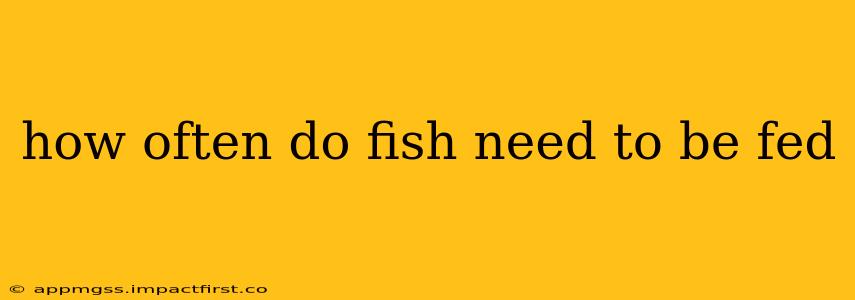Feeding your fish is a crucial aspect of fishkeeping, and getting it right is essential for their health and well-being. Overfeeding can lead to water quality issues, while underfeeding can result in malnutrition and weakened fish. So, how often should you feed your fish? The answer isn't a simple one-size-fits-all, but depends on several factors.
What Type of Fish Do You Have?
This is perhaps the most important factor. Different fish species have different dietary needs and feeding schedules. For example:
- Small, active fish: These fish, like tetras or rasboras, often require more frequent, smaller meals.
- Larger, less active fish: Larger fish, such as goldfish or cichlids, may only need to be fed once a day or even less frequently.
- Specific dietary needs: Certain species may require specialized diets or supplements. Research the specific needs of your fish species to ensure they receive the proper nutrition.
How Much Should You Feed Your Fish?
The amount of food you provide is just as crucial as the frequency. A good rule of thumb is to feed only what your fish can consume within 2-3 minutes. Any uneaten food should be removed to prevent water contamination. Overfeeding is a far more common problem than underfeeding.
How Often Should I Feed My Fish? A Detailed Breakdown
The frequency of feeding is often debated among fish keepers, but here's a general guideline:
- Daily Feeding: Many fishkeepers opt for daily feeding, particularly for smaller, more active species. However, it's crucial to maintain portion control.
- Every Other Day: Some fish, especially larger or less active ones, can thrive on every-other-day feeding schedules. This reduces the risk of overfeeding and water quality issues.
- Fasting Days: Including occasional fasting days (once a week or so) can be beneficial for the health of your fish, mimicking their natural feeding patterns in the wild. This can also help to improve water quality.
What About Different Types of Fish Food?
The type of fish food can influence how often you should feed.
- Flakes: These are convenient and widely available, but they can break down quickly in the water, potentially leading to water quality issues if overfed.
- Pellets: These are generally more nutritionally dense and sink to the bottom, making them suitable for bottom-feeding species. They also tend to break down slower than flakes.
- Live Food: Live foods, like bloodworms or daphnia, are generally considered highly nutritious treats, but shouldn't make up the majority of your fish's diet.
What if My Fish Aren't Eating?
If your fish aren't eating, there could be several reasons. These include:
- Water quality issues: Poor water parameters (ammonia, nitrite, nitrate levels) can significantly impact a fish's appetite.
- Disease or illness: If your fish are lethargic or showing other signs of illness, they might not be interested in food.
- Stress: Introducing new fish, changing tank conditions, or other stressors can also affect their appetite.
Always monitor your fish closely for any changes in behavior or appearance.
How Much Food Should I Give My Fish?
As mentioned earlier, a good rule of thumb is to feed only what your fish can consume within 2-3 minutes. Observe them during feeding time and adjust accordingly.
Can I Overfeed My Fish? What Are the Consequences?
Yes, overfeeding is a serious issue. Uneaten food decomposes, leading to a build-up of harmful ammonia and nitrites in the water. This can cause serious health problems for your fish, potentially leading to illness and death.
What Happens if I Underfeed My Fish?
Underfeeding can lead to malnutrition and weakened immune systems, making your fish more susceptible to diseases. Their growth may also be stunted.
By carefully considering your fish's specific needs and observing their feeding habits, you can ensure they receive the right amount of food at the right frequency. Remember, responsible feeding is key to maintaining a healthy and thriving aquarium environment.
